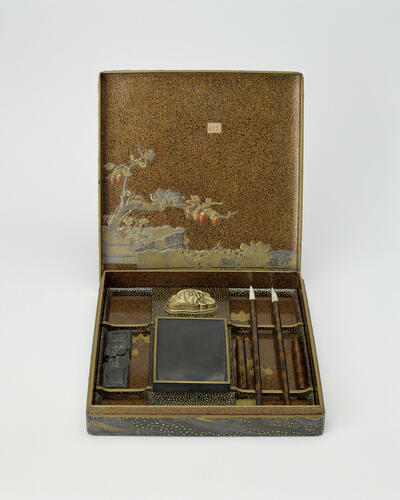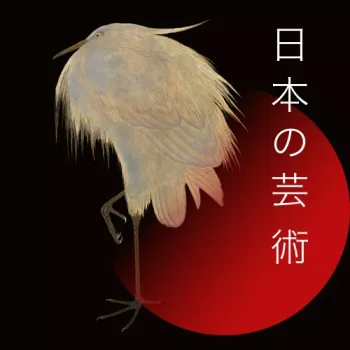Writing box and cover (suzuribako) late eighteenth to early nineteenth century
Black, gold, silver lacquer, coral and horn on wood and gilt bronze | 3.8 x 19.4 x 18 cm (whole object) | RCIN 33949
-
Writing boxes are among the most accomplished of all Japanese lacquerware forms, and their careful craftsmanship reflects the exalted status of calligraphy in Japanese culture. Dedicated boxes for implements were a particularly Japanese tradition, for in China writing equipment was usually arranged directly on the desk itself. By the Edo period (1615–1868), these boxes had become choice vehicles for the lacquerer’s art.
A dragon emerging from a stormy sky was a popular subject among Japanese ink-painters. The motif has its roots in ancient Chinese philosophy, where dragons were associated with water and believed to control rain. This writing box reproduces many features of the genre, including the stylised, scrolling clouds which fill almost half the scene. Large flecks of gold scattered across the black ground suggest a dark night. Gold and silver takamakie of different heights and the upward curling tail of the dragon add dynamism to the composition. The coral jewel in the dragon’s grasp has variously been interpreted as a representation of thunder, the moon or a tide-controlling gem. In this case, the dragon is depicted with three claws, as opposed to the four or five more commonly seen in Chinese depictions from the Song dynasty (960–1279) onwards, which were reserved for use on objects owned by individuals of high rank.
The chronological account of the Emperor Meiji’s reign, Meiji tennō ki, records that he gave Prince Alfred four writing boxes and four incense boxes during his 1869 visit to Japan, of which this is almost certainly one. On the prince’s return to England, the box was exhibited at the South Kensington Museum before being installed in his London residence, Clarence House. It was temporarily displayed at the Bethnal Green Museum after his death in 1900, and later entered the collections of Queen Mary.
Text adapted from Chinese and Japanese Works of Art in the Collection of Her Majesty The Queen: Volume III and Japan: Courts and Culture (2020)Provenance
Almost certainly presented to Prince Alfred, Duke of Edinburgh by Emperor Meiji, while in Japan in 1869.
Lent for exhibition at the South Kensington Museum in 1872 ('The Cruise of His Royal Highness the Duke of Edinburgh, K.G. round the World in H.M.S. "Galatea"...', cat. no. 560).
Recorded in Prince's collection at Clarence House in 1875 (Catalogue of the Collection of ... Specimens of Oriental Art formed by H.R.H. the Duke of Edinburgh ... Also, the collection of ... objects of art and vertu, at Clarence House, St. James's, 1875, p.21).
Loaned to the Fine Art Society Exhibition of Japanese Art at New Bond Street, London, in 1888 (cat. no. 21).
Loaned to the Bethnal Green Museum with other items from the 'Saxe Coburg Collection' on 3 June 1901 (no.617). Recorded in Queen Mary's Private Property Vol. III, no. 175, as 'Box with dragons'. Previously thought by John Ayers to have been acquired by Queen Mary, c.1915. -
Creator(s)
(nationality)Acquirer(s)
-
Medium and techniques
Black, gold, silver lacquer, coral and horn on wood and gilt bronze
Measurements
3.8 x 19.4 x 18 cm (whole object)
Category
Object type(s)
Place of Production
Japan










